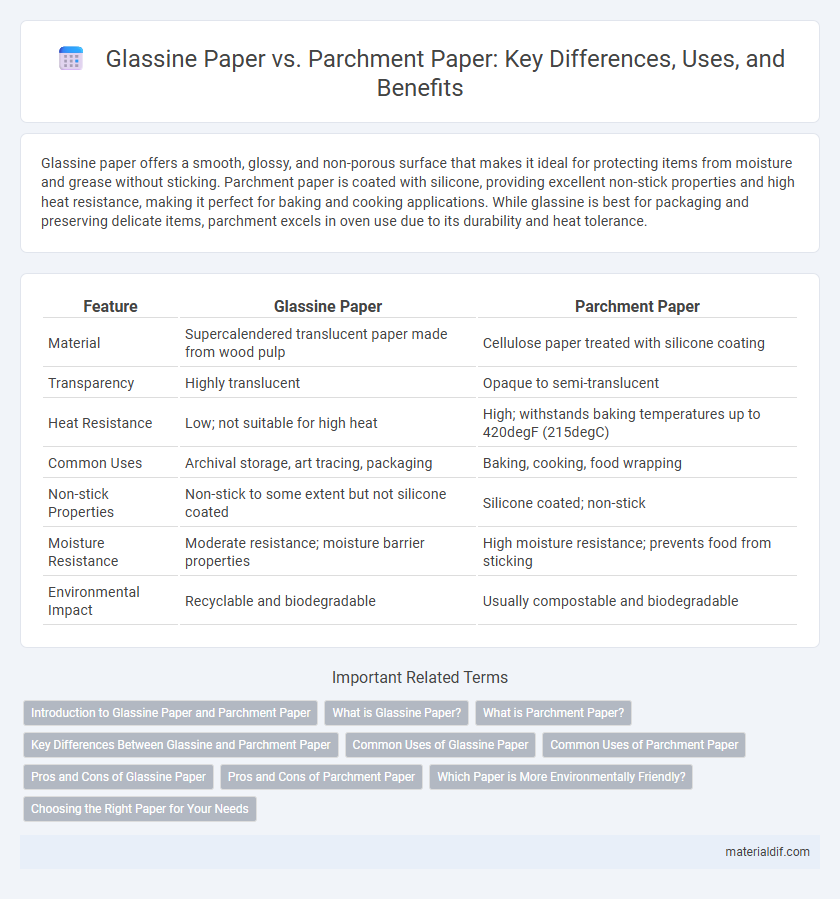Glassine paper offers a smooth, glossy, and non-porous surface that makes it ideal for protecting items from moisture and grease without sticking. Parchment paper is coated with silicone, providing excellent non-stick properties and high heat resistance, making it perfect for baking and cooking applications. While glassine is best for packaging and preserving delicate items, parchment excels in oven use due to its durability and heat tolerance.
Table of Comparison
| Feature | Glassine Paper | Parchment Paper |
|---|---|---|
| Material | Supercalendered translucent paper made from wood pulp | Cellulose paper treated with silicone coating |
| Transparency | Highly translucent | Opaque to semi-translucent |
| Heat Resistance | Low; not suitable for high heat | High; withstands baking temperatures up to 420degF (215degC) |
| Common Uses | Archival storage, art tracing, packaging | Baking, cooking, food wrapping |
| Non-stick Properties | Non-stick to some extent but not silicone coated | Silicone coated; non-stick |
| Moisture Resistance | Moderate resistance; moisture barrier properties | High moisture resistance; prevents food from sticking |
| Environmental Impact | Recyclable and biodegradable | Usually compostable and biodegradable |
Introduction to Glassine Paper and Parchment Paper
Glassine paper is a smooth, glossy, and translucent paper often used for packaging and protecting delicate items due to its grease-resistant and moisture-resistant properties. Parchment paper, crafted from cellulose fibers treated with sulfuric acid, offers a non-stick, heat-resistant surface ideal for baking and cooking applications. Both papers serve distinct functions: glassine excels in archival protection and wrapping, while parchment is preferred for food preparation and heat exposure.
What is Glassine Paper?
Glassine paper is a smooth, glossy, and translucent paper made from highly refined pulp that has been pressed and supercalendered to create a dense and grease-resistant surface. It is commonly used for packaging, interleaving, and protecting delicate items such as photographs, artworks, and food products due to its non-stick and moisture-resistant properties. Unlike parchment paper, glassine paper does not have a silicone coating, making it less heat-resistant but more transparent and ideal for archival purposes.
What is Parchment Paper?
Parchment paper is a heat-resistant, non-stick paper commonly used in baking and cooking to prevent food from sticking to surfaces. It undergoes a silicone coating process that makes it moisture-resistant and suitable for oven temperatures typically up to 420degF (215degC). Unlike glassine paper, parchment paper provides superior non-stick properties and heat tolerance, making it ideal for lining baking sheets and wrapping food.
Key Differences Between Glassine and Parchment Paper
Glassine paper is a smooth, glossy, and translucent paper often used for protecting artwork and food wrapping, known for its resistance to air and grease but not heat. Parchment paper is a non-stick, heat-resistant paper commonly used in baking and cooking to prevent food from sticking and to withstand high oven temperatures. The key differences lie in their heat resistance and non-stick properties, with glassine offering moisture resistance and clarity, while parchment provides durability under heat and a silicone coating for non-stick performance.
Common Uses of Glassine Paper
Glassine paper is commonly used for food packaging, particularly for bakery items and candies, due to its grease-resistant and moisture-resistant properties. It is also popular in the art world for protecting photographs, stamps, and delicate documents without sticking or causing damage. Additionally, glassine paper serves as an interleaving paper in industrial applications, preventing scratches and preserving surface quality during storage and transport.
Common Uses of Parchment Paper
Parchment paper is widely used for baking and cooking due to its non-stick and heat-resistant properties, making it ideal for lining baking sheets and cake pans. Its moisture-resistant surface prevents food from sticking and allows for even heat distribution during cooking or baking processes. Common applications include roasting vegetables, baking cookies, and wrapping food for steaming or storage.
Pros and Cons of Glassine Paper
Glassine paper offers excellent grease resistance and translucency, making it ideal for food packaging and art preservation, but it lacks heat resistance compared to parchment paper. Its smooth, non-porous surface prevents moisture and odors from passing through, enhancing product protection. However, glassine paper is less durable when exposed to water, limiting its use in high-humidity environments.
Pros and Cons of Parchment Paper
Parchment paper offers excellent non-stick properties and heat resistance, making it ideal for baking and cooking without the need for additional grease or oils. It is moisture and grease-resistant, which helps preserve food texture and prevents sticking during high-temperature applications. However, parchment paper is not as durable for long-term storage or wrapping compared to glassine paper and can become brittle under excessive heat or prolonged use.
Which Paper is More Environmentally Friendly?
Glassine paper is more environmentally friendly than parchment paper due to its production process, which uses fewer chemicals and results in a biodegradable and recyclable product. Parchment paper often undergoes silicone coating, making it less compostable and harder to recycle. Choosing glassine paper reduces environmental impact by minimizing chemical use and promoting sustainability through easier decomposition and reuse.
Choosing the Right Paper for Your Needs
Glassine paper offers a smooth, glossy, and translucent surface ideal for protecting delicate items without sticking, making it perfect for storing collectibles or wrapping baked goods. Parchment paper is coated with silicone, providing a non-stick, heat-resistant surface suited for baking and cooking tasks that require high temperatures. Selecting between glassine and parchment paper depends on whether your priority is moisture resistance and protection (glassine) or heat tolerance and non-stick performance (parchment).
Glassine Paper vs Parchment Paper Infographic

 materialdif.com
materialdif.com